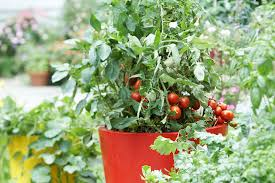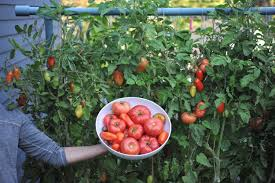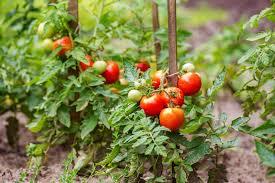Tomato is a vegetable locally produced and highly consumed around the world. Almost on a daily basis every person has to eat a tomato in their food.
Tomato plants come cheap, yield pounds of produce, and fit in even the smallest backyards or balconies. With that being said, you have to grow them under certain conditions to get perfect, ready-to-eat tomatoes a.k.a. ones that are firm yet juicy, and sweet yet tangy.
Growing tomatoes is a fun and rewarding task, resulting in masses of fresh, nutritious tomatoes that taste better than anything you can buy in the shops. Tomatoes are easy to grow and taste best when grown in full sun.
Tomatoes require a long growing season, so your best bets are to buy plants or start seeds indoors 4 to 6 weeks before your last frost date. Either way, you want a stocky, 6- to 10-inch tall transplant ready to go into the garden after all danger of frost has passed.
There are many different varieties to grow, including cherry, plum and beefsteak, each with its own distinctive shaped fruit, flavour and culinary use.
Common Varieties Grown

The choice of a Tomato cultivar is based on fruit quality, adaptability and reliability, susceptibility to diseases and pests.
Varieties include:
– Rio Grande, Star and many more others
It’s advisable to go for a hybrid seed for commercial farmers since these seeds are high yielding, resistant and produce durable fruits.
Tomatoes Growing Requirements
Tomatoes give good results when grown in well managed sandy loams and heavy clay loam free of hard pan.
Best results are obtained in deep, well drained loams. The soil should be rich in organic matter and plant nutrients, with a pH value of 6 to7.
Read Also: Planting, Growing and Harvesting Tomatoes (Solanum lycopersicum)
Propagation of Tomatoes

They are best brought up using seeds. However you can also use cuttings from mature plants to get more seedlings
(1) Nursery Preparation
You can Broadcast the seeds on the raised bed and lightly cover with soil.
Or else you can create shallow lines using your finger and place the seeds there, then cover with little soil.
(2) Transplanting
In one acre, you plant over 8000 plants with a spacing of 2*2ft.
Seedlings are usually ready for transplanting 2-3weeks after sowing, and they must be transplanted on moist soil.
At transplanting you may use a fertilizer like DAP, place a few granules in the hole, Cover with some soil, then plant your seedling.
Of you can use farm yard manure, you apply 2hand fulls in each hole, mix it with soil and transplant.
Management Practices

(1) Fertilization
They are heavy feeders of plant nutrients including nitrogen, phosphorus and potassium. The plant responds well to organic fertilizers too.
After 1 month from planting, you have to start applying folliar fertilizers like Vegimax to boost the growth of the crop.
(2) Weed control
These can be controlled chemically or mechanically. Alternatively hand hoes can be used to shallowly plough off the weeds.
Avoid using herbicides when the plants are already in the field.
Read Also: Tomato Russet Mite: Symptoms and Control
(3) Pruning
This practice influences the flowering and fruiting of tomato plants. Prune plants by pinching off lateral branches as they appear in the leaf axils.
The more you reduce excess leaves and branches, the more space you leave for the plant to use nutrients for fruit development.
(4) Mulching
Mulch newly planted tomatoes in order to retain moisture in the soil and avoid weeds from growing.
A heavy mulch is very good for our tomato plants. You can use dry grass, saw dust, coffee husks and many others
(4) Pest control
You have to control the insects and diseases that normally attached k the tomatoes. Normally they are affected by insects and Fungal infections.
Here you need to start applying an Insecticide (Dudu Acelamactine/Cyperscope) and a Fungicide (Mancozeb/Indofil) at once.
Then spray every week starting from 1month till flowering. It’s good to seek advice from a plant doctor before buying any chemical to spray.
(5) Stalking
After they have grown, the stems become vulnerable and weak hence need support.
You can use strings tied upwards or you can tie logs of trees on each plant.
This is more effective on high yielding tomatoes since they take long.
(6) Irrigation/watering
After planting, you must water them if it’s off season or in times of no rain.
You have to water evening or morning.
(7) Harvesting
After transplanting, you can start harvesting at 2 and half months.
For hybrid high value varieties, you can harvest for the next 6 months
Harvest your tomatoes before they get to fully ripen.
It’s advisable to leave some inches of a stalk on the fruit as you harvest, this will keep it fresh for sometime.
Pre-harvest interval for tomatoes if 2weeks, after spraying with pesticides, you have to wait for 2weeks to harvest.
Read Also: Comprehensive Guide to Dry Beans Production






